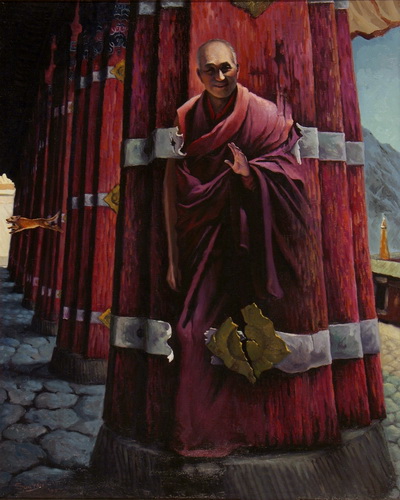Acquisition Number: 2007.13
Medium:
Oil on canvas
Size:
29 1/2" x 23 1/2"
Date:
1993
Credit: Gift of the artist
“Nothing-Anything is an example of inspiration arising from memories of living in Tibet, observing religious worshippers and their religious engagements that occur in endless circles and cycles. I was very much shocked by the way they worship Buddha, sometimes enduring extremely painful physical exercises which express the intensity of their spiritual beliefs.
Working among the Tibetan people left a lasting impression on the art creation procedure.
Observing some very extreme forms of worship in Tibet, some of which involved grave bodily injury, lead one to pondering about the relationship and the problems between life and the religions which attempt to explain the meaning of life, and in doing so, thoughts and feelings. One of the interests is in the life-circle in Buddhist thought. The other is in the idea of “empty” or “nothing.” And these two elements have the same emphasis, that is, this life is a preparation for the future LIFE, where one attains a meaningful “emptiness” or “nothingness.” The more one suffers in this life, the more one will be rewarded in the afterlife. Also, material existence has no meaning. The “nirvana” is actually untranslatable; if there is no “heaven” but total liberation, a unity with the unknown – the mystery itself. In painting Nothing-Anything, the negative space is painted red to create a claustrophobic sense, the red expands and seems to push out life itself. The red color symbolizes NIRVANA and the feeling of being unable to escape from real life situations. This is a paradox. Seemingly absurd elements such as the monk emerging from the column and the levitating dog suggest an otherworldly reference. The levitating dog does not step in the solid ground, but is in the air, i.e. in between the reality, and that which is unseen. Vertical and horizontal lines are crucial in the composition, and are important in expressing the idea about empty, or nothing.
The change of time and space helps to express the subject. Perhaps it is absurd that the Buddhist monk appears in a column. That’s impossible in real life. But according to Buddhism, especially the Zen Sect, everything is empty and everything is created from the mind. Since everything comes out of the mind, the monk coming out of the column is not unusual according to Zen philosophy. The Buddhist monk spreads the thoughts of Buddhism; he himself is the embodiment of Buddhism – he holds up the ideas of Buddhism in the world. So he is the column of Buddhism; he and the column are one, and this is expressed by his coming from the column. He also comes from emptiness. For the insightful human heart, the “confused” images enhance the subject of the painting."
Yan Sun
|
